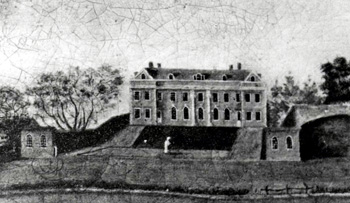The Manor of Leighton Prebends

All Saints Church and Prebendal House 1797 [P91/28/40]
The Domesday Book records that the Royal Manor of Leighton contained forty seven hides. The Crown farmed forty three hides directly and the other four were held from him by Bishop Remigius of Lincoln. The Bishop's holding included six villagers and six smallholders and was valued at £4 and had been held before the conquest by a Bishop Wulfwy.
This was the origin of the Manor of Leighton Prebends. A cathedral church, such as Lincoln, had a number of prebends; they were ordained clergy who had a role in the administration of the cathedral as well as a parish, though they usually relied on a surrogate, called a vicar, to perform the duties of parish priest. The prebend's income came from cathedral estates such as the Manor of Leighton Prebends. The fact that Leighton Buzzard had a prebend meant that it later became a Peculiar Jusridiction, not subject to the Archdeacon of Bedford.
In the same way that the tenants of Grove Priory disputed the prior's rights to impose service on them so the tenants of this manor brought an action in 1247 against the prebend who wished to impose additional measures on them. They claimed that since Domesday they had paid 4 pence a year per virgate, did two services in winter (during one of which they were fed by the prebend) and in summer made hay in the prebend's field called Bellammede. They refused to pay additional taxes the prebend sought to lay on them and refused to act as his reeves. In 1340 the manor was valued at £22/10/8 per annum.

The Prebendal House in the 18th century [Z50/72/57]
In 1583 Sir Christopher Hoddesdon, who leased the Manor of Leighton Buzzard alias Grovebury from at least 1587, leased the Manor from the prebend. Again, like the Manor of Leighton Buzzard, he was followed as tenant by the Leigh family of Stoneleigh. After the execution of Charles I in 1649 the trustees for the sale of church lands entered into an agreement with George Smith of London in 1650 to sell him the Prebendal Estate which, at that time, comprised the Prebendal House, Dovecote Close, Parsonage Close, Parsonage Hooke and Robery Field but at the Restoration in 1660 this sale was voided and the Leighs once more acquired the lease from the prebend and continued to hold the manor with that of Leighton Buzzard.
The Manor had its own mansion, the Prebendal House, which survived into the 19th century at the end of Judge's Lane, the site now being occupied by some of the buildings, playground and playing fields of Leighton Middle School. Bedfordshire & Luton Archives & Records Service has the following documents relating to the manor:
- KK792: manorial court roll detailing business transacted at each court: 1448 to 1459;
- KK85-104: deeds to the Manor: 1550 to 1705;
- KK793: manorial court roll: 1588 to 1591;
- KK794: manorial court roll: 1611-1612;
- KK795: manorial court roll: 1613 to 1617;
- KK796: manorial court roll: 1617 to 1622;
- KK797: manorial court roll: 1627;
- KK798: manorial court roll: 1631;
- KK799: terrier of manor lands: 1650;
- KK801: particular of the manor and its holdings: 1717;
- KK802: terrier of glebe lands: 1724;
- KK808: reference table for a first floor and attic plan of the Prebendal House: late 18th century;
- KK805: account of tithe and glebe: early 19th century;
- KK806: terrier of gardens and land adjoining the Prebendal House: early 19th century;
- KK809: estimate of manorial repairs: early 19th century;
- KK800: abstract of KK799 with names of contemporary tenants: c.1807